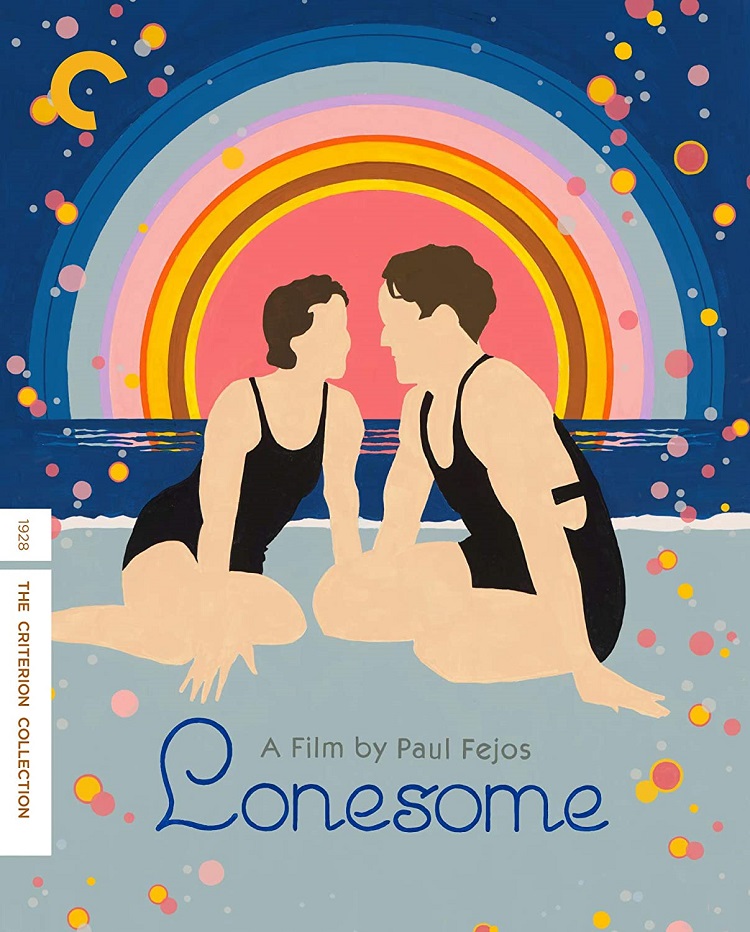
Paul Fejos (1897-1963) directed something of a “lost” classic with Lonesome (1928). The Criterion Collection have just released a digitally remastered edition of Lonesome, along with two more Fejos films in an exclusive two-DVD set. Lonesome put Fejos among the select few of director’s directors. Although the film was not hugely successful upon release, it has developed a reputation as one of the most creative and influential films of all time.
The basic story was adapted from a story about loneliness in large American cities. It is sort of a timeless subject. Set in the then-current New York City, the hustle and bustle of the daily grind wears down Jim (Glenn Tryon) and Mary (Barbara Kent). Both are constantly surrounded by people, yet go home alone each night. On Fourth of July weekend, they both go to Coney Island, where they meet and have a marvelous time together. When the rwo are separated by the crowd, both are terrified. It was love at first sight, yet neither had taken the time to find out where the other lived, or any other information. They were simply enjoying themselves.
The “feel good” ending was probably always there in the script, as at the conclusion, Mary and Jim discover that they live in adjoining apartments. What is definitely “tacked on” are the awkward dialogue segments, included at the producer’s request in response to the success of The Jazz Singer (1927). It was only natural that audiences would go for “talkies” when they were introduced. I think that is pretty obvious. But the form of silent film was completely different from a movie with dialogue.
In silents, the “strokes” were (by necessity) much broader. This forced the viewer to work a bit, by inferring much of the plot. This is one reason (I believe) that Chaplin resisted using dialogue for so long. And his point that once the Little Tramp spoke, it would be all over for the character was dead-on. Nevertheless, Fejos added three dialogue segments, which do not really advance the plot at all, and actually are more of a distraction than anything else.
On the other hand, the hand-tinted segments done in post-production are marvelous. They are used to underscore the joy that Jim and Mary feel in each other’s company and at the marvels of the circus-atmosphere of the rides at Coney Island. There are also a number of montages used throughout, which do an excellent job of illustrating the thoughts of the characters as they go through their mind-numbing workaday lives.
The running time of Lonesome is 69 minutes. It is joined on the first DVD of the set by Fejos Memorial (1963). This is a visual essay, produced by Paul Falkenberg, in collaboration with Fejos’ wife, Lita Binns Fejos. The 20-minute piece features the filmmaker narrating the story of his life and career with still photographs providing illustration.
The second DVD features two more Fejos films, The Last Performance (1929) and Broadway (1929). The Last Performance is also a “part silent, part talking” picture. The film stars Conrad Veidt as a magician who falls in love with his assistant. Like Lonesome, the dialogue is a bit awkward, and the story itself is not all that compelling. It is a nice extra however, and worth viewing.
As far as “bonus” material goes, Broadway is the most significant. Fejos was obviously very busy in 1929, as both of these movies were made that year. Although Broadway does not have the reputation Lonesome does, this is probably due (at least in part) to the fact that much of it has been lost over the years. One of the reasons film buffs look to Criterion for the definitive versions of films, and bonus segments, is the amount of work they put into their releases.
For Broadway, this involved a literal reconstruction of the movie from various sources. The 1:44 Broadway holds the distinction of being Universal’s first talking film with Technicolor sequences. Both silent and talking versions of the movie have survived, but the talking version is incomplete. Thus, the reconstruction involved to present the talking version of the film took a fair amount of work.
The plot of Broadway is somewhat melodramatic. Roy Lane (Glenn Tryon) and Billie Moore (Merna Kennedy) are lovers performing at the Paradise Nightclub. Steve Crandall (Robert Ellis) is a mob heavy who wants Billie, and is willing to kill Roy to get her. The film’s reputation among critics has little to do with the story, end everything to do with the Technicolor finale. Thankfully, the sound version of this scene has survived intact, and it remains quite impressive.
Besides the two films on the second DVD, there is a seven-minute interview with Broadway cinematographer Hal Mohr (from 1973). Criterion has also included a 32-page booklet with a number of essays about Fejos, and the films themselves. I am continuously impressed with the efforts put into the Criterion Collection series of films, and the company have certainly done it again with Lonesome. While the historical value of the package is without question, the filmmaking talents of Fejos on display here remain highly impressive as well. The various silent scenes of Lonesome, and the Technicolor finale of Broadway are both brilliant. For fans of ground-breaking cinema, this release should not be missed.